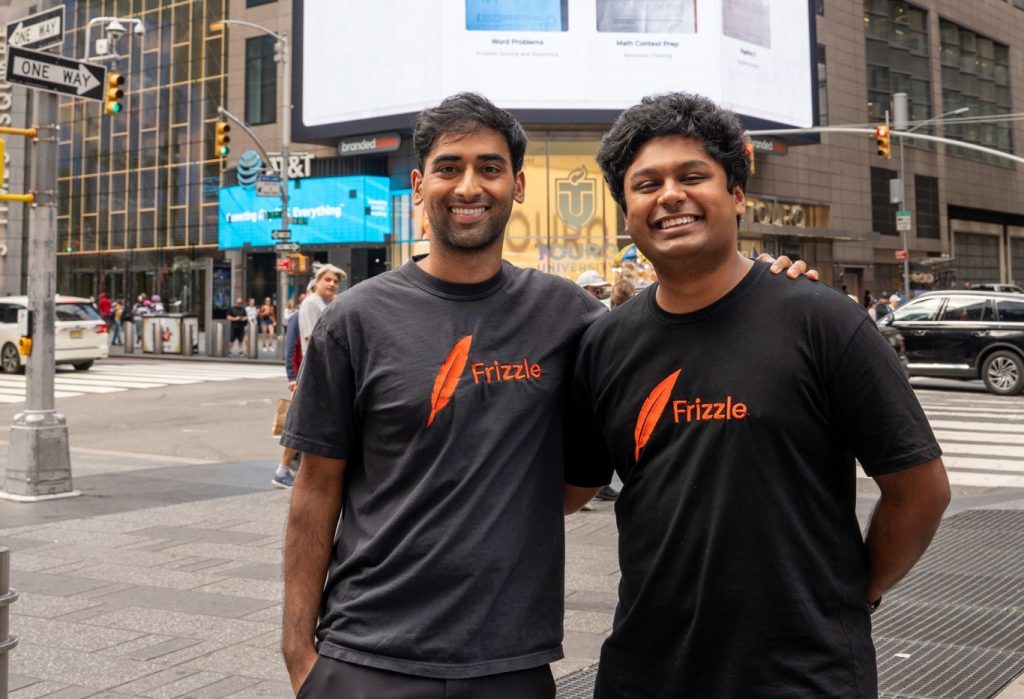Frizzle is building AI that reads messy math homework like a real teacher. Founded by longtime friends Abhay Gupta and Shyam Sai, the YC-backed startup helps educators turn stacks of handwritten work into instant feedback, saving hours each week while giving students faster, clearer corrections.

Abhay Gupta and Shyam Sai, co-founders of Frizzle, photographed in New York City.
1. Frizzle promises to give teachers back the 10–15 hours they lose every week to grading. What’s the deeper problem you’re solving — and why hasn’t anyone truly fixed it before?
Abhay Gupta: Teachers aren’t just losing time, they’re losing the energy and insight needed to actually teach. Grading is the most manual, repetitive part of their job, yet it’s also where the richest data about how students think lives. And no one’s been able to automate it because handwriting, math reasoning, and open-ended work are notoriously hard for AI to interpret. Frizzle finally bridges that gap, turning handwritten student work into instant feedback and actionable insights teachers can trust.
2. You’ve known each other since high school. What was the exact moment you decided to build Frizzle? Was it frustration, inspiration, or something in between?
Abhay Gupta: It was a mix of both. We’d always loved math and teaching, and we even started one of Chicago’s biggest math circles back in high school. But every teacher we knew kept saying the same thing: grading was breaking them. The moment came when we watched one of our mentor teachers stay up past midnight grading worksheets by hand, and we realized AI could finally take that pain away and give teachers their time back.
3. Most AI grading tools fail with math, especially handwritten work. What made you realize this was the hard part worth solving — and what early mistake taught you the most?
Abhay Gupta: We realized math was the hardest and most valuable frontier as it’s the only subject where students show their reasoning step by step, and that’s exactly what existing AI tools ignored. Early on, we tried using off-the-shelf handwriting models and quickly learned they crumble when faced with real classroom messiness such as crossed-out work, partial credit, student doodles. That failure taught us that to truly solve this, we had to build our own math-specific AI from the ground up, trained on authentic student work rather than sanitized data.
4. Every startup fights skepticism. What’s the most common misunderstanding you face from educators or technologists, and how do you change their mind?
Abhay Gupta: Educators often worry we’re trying to replace teachers, when in reality we’re doing the opposite: giving them back the time and insight to focus on what only they can do: teach. Technologists, on the other hand, underestimate how nuanced classroom data really is; they think grading is just image recognition. We change minds by showing real results, with teachers saving 10+ hours a week and students improving because feedback comes the same day, not a week later.
5. Walk us through how Frizzle actually works — from the photo of a worksheet to feedback on a student’s reasoning. What’s the hardest part technically, and how did you get it right?
Abhay Gupta: A teacher snaps a photo of a stack of handwritten math worksheets, and within seconds, Frizzle’s AI reads every step of each student’s work, identifying where reasoning breaks down and writing red-ink feedback right on the page. Behind the scenes, our pipeline combines vision models that understand handwriting with reasoning models trained specifically on student problem-solving patterns. The hardest part was getting the AI to interpret messy, partial, and nonlinear reasoning like a human teacher would, and we solved it by training on millions of real classroom samples rather than perfect digital data.
6. You’re not just grading; you’re giving step-by-step feedback. How do teachers and students respond when they see that feedback for the first time?
Abhay Gupta: Teachers’ first reaction is relief and recognition, “this reads like me,” because the comments mirror how they’d coach, step by step, not just mark right/wrong. They immediately use it to plan same-day reteach and faster 1:1s, while students see exactly where their reasoning veered and what to try next, so corrections start on the spot and grading becomes a tight feedback loop instead of a week-long mystery.
7. You call Frizzle “a partner in the classroom.” What’s something teachers have asked you to build that completely changed your roadmap?
Abhay Gupta: Teachers asked us to go beyond grading and actually teach through feedback, to help students learn from mistakes instead of just seeing a score. That request completely shifted our roadmap: we started building adaptive feedback and reteach suggestions right into the grading flow, so Frizzle could act like a co-teacher that not only evaluates work but guides students’ next steps. It turned Frizzle from a grading tool into an instructional partner.
8. Frizzle was named an official White House AI Education Partner. What does that mean in practice — funding, pilots, visibility — and what are you doing with that credibility now?
Abhay Gupta: Being named an official White House AI Education Partner gave us national visibility and direct collaboration with districts shaping AI policy. We’re also leveraging top-down distribution through the Department of Labor’s AI rollout initiative, which is unlocking new grant funding and large-scale pilot opportunities for Frizzle. Together, these partnerships have turned recognition into reach, accelerating adoption, trust, and real classroom impact.
9. There’s always a trade-off between automation and human judgment. How do you make sure Frizzle helps teachers rather than replaces them?
Abhay Gupta: We’ve built Frizzle to enhance human judgment, not replace it. Teachers stay in full control as every piece of feedback is reviewable and editable, and if our AI is ever unsure about a response, it flags it for manual review rather than guessing. That way, automation handles the repetitive work while teachers focus on what only they can do: interpreting nuance, mentoring students, and shaping learning with empathy and expertise.
10. Building for classrooms isn’t like building for consumers. What’s been the hardest part of getting schools to adopt Frizzle, and what’s worked best in earning trust?
Abhay Gupta: The hardest part has been navigating the long decision cycles and deep trust barrier in education where schools don’t just buy tools, they build relationships. What’s worked is starting teacher-first: letting real educators test Frizzle in their classrooms, see time saved, and share results with their principals. That bottom-up credibility, combined with our district pilots and partnerships through the Department of Labor and White House AI initiative, has turned early adopters into our strongest advocates.
11. Abhay, you’ve led product at Coinbase and Tesla; Shyam, you’ve worked in AI at Microsoft and Meta. How do those experiences shape how you run Frizzle — and what have you had to unlearn?
Abhay Gupta: Those experiences taught us how to build at scale, specifically ship fast, measure impact, and obsess over reliability, which is why Frizzle feels polished and dependable even in classrooms. But we had to unlearn the “move fast and break things” mindset. In education, trust and empathy matter more than speed. Building for teachers means slowing down to listen, designing with care, and proving value before asking for adoption.
12. YC teaches founders to move fast. Education doesn’t. How do you balance the speed of a startup with the slow, trust-based world of schools?
Abhay Gupta: We move fast on product, but slow on trust. YC taught us to ship, test, and iterate quickly so we can respond to teachers’ needs in days, not months. In education, real adoption only happens when schools feel safe and heard. Our balance is simple: experiment like a startup, but deploy like a school district partner where we’re grounded in transparency, reliability, and proof of impact.
Editor’s Note
This interview explores how Frizzle blends AI and empathy to support real classrooms, not replace them. From grading accuracy to White House recognition, Gupta shares how the team is turning automation into a teacher-aligned co-pilot for instruction.


